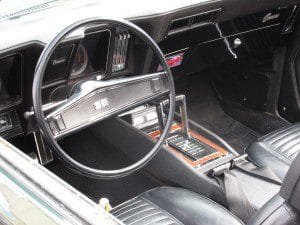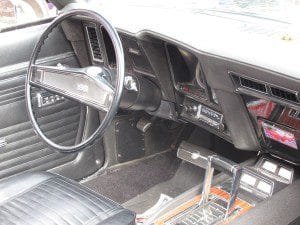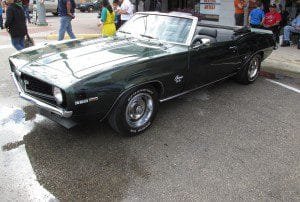The 1969 Chevrolet Camaro featured here is a fine classic performance automobile. If there was ever a 1960’s car that resembled the Ford Mustang this is it. Chevrolet answered the Mustang with virtually the same formula. This included the same chassis, wheelbase and powertrain. About as close as you could get. The Chevy Camaro followed the long hood short deck Mustang formula but in a swoopier fashion.

Chevrolet came out with their Camaro in September of 1966. The first generation Camaros ran from the 1967 through the 1969 model years. This was Chevy’s first offering against the Ford Mustang and their target market for buyers was the same. As an added promotional boost the 1967 Chevy Camaro was the pace car at the Indy 500 that year.
The 1969 Chevy Camaro
The 1969 Chevy Camaro saw some design changes since 1968. You would describe them as giving the car a more aggressive look. The Camaro’s body had the appearance of being longer and lower and the wheel wells were flattened. The front bumper was full width and the rear taillights were redesigned. Another change for 1969 were square dashboard gauges instead of the round ones from 1968.
The Chevrolet Camaro SS model came with a 350 or 396 cubic inch V-8 putting out an impressive 325 horsepower. In 1969 a 427 cubic inch V-8 delivering an even more impressive 425 horsepower was an option.

Interestingly, Chevrolet actually printed advertising featuring both the Camaro and it’s Corvette models as being an aerodynamic duo. Both were positioned as performance automobiles but there would have been a difference in it’s targeted market.
The 1969 Chevy Camaro Z 28
This was step above the Camaro SS power and added only about $450 to the base price of the 1969 Camaro coupe. The Camaro Z 28 in 1969 had a redesigned 302 cubic inch small block V-8 and was only offered on the Camaro coupe. The Z 28 package was revised about mid year with the added cost to the coupe proce going up to about $500.
The Rare Chevy Camaro ZL 1
If you’re talking about the 1969 Chevy Camaro you have to take a look at the Camaro ZL 1. A Chevy dealer came up with an idea that led to the creation of the ZL 1 model. This was a Camaro with an all aluminum and modified 427 cubic inch V-8 which some referred to as the ultimate muscle car. Horsepower was said to 425. The dealer wanted to purchase fifty of these Super Stock cars after they were built. The dealer was expecting to purchase the cars for around $5,000 each but by the time they were built the factory invoice price rose to around $7,200.

Included with the ZL 1 were J 50 power brakes, the Z 22 rally Sports package, an N 40 power steering and a V 10 tachometer. Racing magazines at the time claimed that the Camaro ZL 1 could do the quarter mile in 10.1 seconds. The speed reached was 139 MPH.
In addition to these fifty ZL 1’s another nineteen were built for other Chevy dealers.
The ZL 1 is still being built by Chevrolet as of this writing. Chevrolet claims that the 2014 C Camaro ZL 1 is the highest Chevrolet performance car ever. For 2014 you can choose a 6.2 liter supercharged V-8 delivering a stunning 580 horsepower.
The 1969 Camaro SS Vs. The 1969 Ford Mustang
Since these two popular performance cars were essentially vying for the same market, it’s interesting to compare their respective specs and attributes. The comparison for the 1969 model year looks like this…
Wheelbase– Camaro 108.1 inches…Mustang 108.0 inches
Overall length- Camaro 186.0 inches…Mustang 183.6 inches

Weight– Camaro about 2,900 lbs on average…Mustang 2,750 lbs on average
Engines– Camaro’s two highest performance engines were the 396 and the 427 cubic inch V-8’s…Mustang offered a variety of engines, the two largest being a 390 and a 428 Cobra Jet. The Ford Mustang that year also had a 429 cubic inch Boss 429 which was a rare engine.
Transmissions– 1969 Chevy Camaro buyers could choose from a three or four speed manual or a two or three speed automatic. Ford Mustang buyers in 1969 had the option of a three or four speed manual or a three speed automatic.
1969 Chevrolet Camaro Specifications
As mentioned above, the two engines available to 1969 Camaro SS buyers were a 350 396 and even a 427 cubic inch size V-8.
Transmission choices included a three speed manual, a special three speed manual, a four speed manual, a Powerglide automatic and a Turbo Hydra-Matic.
Front suspension were coil springs with rear suspension of two semi elliptical single leaf springs.

Brakes on the Camaro were four wheel drum.
As mentioned above, the car’s wheelbase was 108.1 inches and it’s overall length was 186.0 inches. The length was increased from the 184.7 inches on the 1967 and 68 models.
Total Chvey Camaro 1969 production was 243,085 vehicles.. The Sport Coupe was the highest production model with 165,226 built and was the Camaro base model. Comaro Convertibles produced in 1969 totaled 17,573.
The new car base price of the 1969 Chevy Camaro Coupe was about $2,700. As mentioned above a buyer could add the Z 28 package for about another $500.
Compare the Chevy Camaro to the cars on our AutoMuseumOnlne articles linked below…

The 1969 Chevrolet Camaro Collector Car
Being the last model year of the first generation, the 1969 Chevy Camaro could be the most popular of all the Camaros. Models offered during 1969 included the Sport Coupe, the Super Sport and the Z/28.
Mint condition museum quality restorations can have price tags from the $30,000 plus range right up into six figures. The 1969 Camaro SS Convertible featured in this article could also be considered relatively rare as only 17,543 were built. It was also the last designed Camaro convertible in the first generation series.
(Article and photos copyright 2013 AutoMuseumOnline)